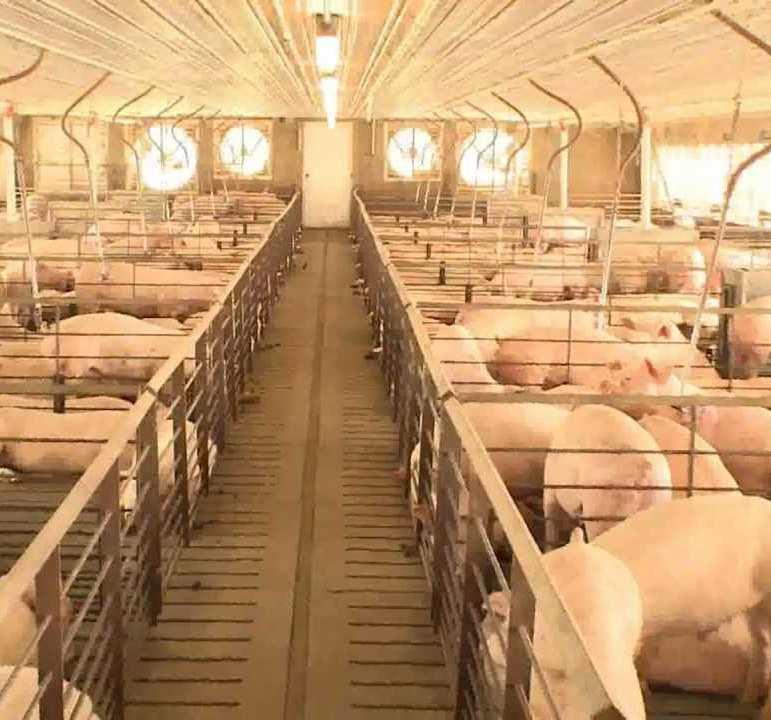
Lighting is a cornerstone of modern swine production, directly impacting growth rates, reproductive success, and animal welfare. Unlike other livestock, pigs have distinct visual and behavioral needs that demand specialized lighting strategies. From farrowing houses to finishing barns, a well-designed lighting system enhances productivity while reducing stress and energy costs. This article explores the science, technology, and best practices behind effective swine lighting.
1. The Role of Light in Swine Production
A. Biological and Behavioral Influences
Pigs rely on light to regulate critical biological processes:
- Growth Performance: Proper lighting stimulates feeding activity, improving feed conversion ratios (FCR).
- Reproductive Health: Light duration and intensity synchronize sow estrus cycles and farrowing rates.
- Stress Mitigation: Gradual light transitions mimic natural dawn/dusk, reducing aggression and tail-biting.
B. Key Lighting Parameters
- Photoperiod (Light Duration):
- Sows and Piglets: 14–16 hours of light to support lactation and piglet vitality.
- Growing/Finishing Pigs: 8–12 hours to balance growth and rest.
- Light Intensity:
- Farrowing Areas: 100–200 lux for caregiver visibility and piglet health monitoring.
- General Housing: 40–80 lux for normal activity (avoid exceeding 200 lux to prevent stress).
- Light Spectrum:
- Blue-White (5000K): Enhances alertness during feeding periods.
- Red Light (600–700 nm): Calms pigs during rest and nighttime checks.
2. Designing an Optimal Swine Lighting System
A. Stage-Specific Lighting Strategies
- Farrowing Rooms:
- High Intensity: 150–200 lux ensures caregivers can monitor sows and piglets effectively.
- Uniform Coverage: Eliminate dark corners where piglets might cluster, increasing crushing risks.
- Weaning/Growing Areas:
- Controlled Photoperiod: 12–14 hours of light to encourage consistent feeding.
- Zonal Lighting: Brighter zones near feeders (80 lux) and dimmer resting areas (40 lux).
- Finishing Barns:
- Balanced Cycles: 8–10 hours of light to optimize growth without overstimulation.
B. Fixture Selection and Installation
- LED Technology:
- Energy Efficiency: 60–70% savings compared to traditional lighting.
- Durability: IP65-rated fixtures withstand humidity and frequent washdowns.
- Adjustability: Tunable spectra (e.g., blue-white for daytime, red for night checks).
- Placement Guidelines:
- Mount fixtures 3–4 meters above floors for even light distribution.
- Space fixtures 4–5 meters apart in large barns to avoid shadows.
C. Smart Controls and Automation
- Timers: Maintain consistent schedules (e.g., 6 AM to 8 PM for sows).
- Dimmers: Simulate 20–30-minute sunrise/sunset transitions to reduce stress.
- Motion Sensors: Activate bright lights only during inspections or feeding.
3. Energy Efficiency and Sustainability
A. LED Retrofitting
- Case Study: A Midwest finishing barn reduced energy costs by 58% after replacing 300 fluorescent fixtures with dimmable LEDs.
- ROI: Payback typically achieved in 1–3 years through energy savings and reduced bulb replacements.
B. Solar-Powered Systems
- Off-Grid Solutions: Solar panels power LEDs in remote farrowing huts or pasture-based operations.
- Battery Backup: Ensure uninterrupted lighting during power outages.
C. Reducing Light Pollution
- Full-Cutoff Fixtures: Direct light downward to comply with rural light trespass laws.
- Light Curtains: Install around barn openings to contain spillage.
4. Common Pitfalls in Swine Lighting
- Overlighting: Intensity >200 lux increases stress, leading to tail-biting and reduced gains.
- Inconsistent Schedules: Erratic photoperiods disrupt feeding patterns and growth cycles.
- Poor Spectrum Choices: Blue-rich light at night disturbs circadian rhythms, affecting sleep and immunity.
5. Innovations in Swine Lighting Technology
A. Smart Barn Integration
- IoT Systems: Monitor and adjust lighting remotely via smartphones or cloud platforms.
- Behavioral Analytics: Cameras detect aggression or illness, triggering light adjustments (e.g., red light to calm agitated pigs).
B. Circadian Lighting
- Dynamic Spectra: Shift from cool white (5000K) at dawn to warm white (3000K) at dusk.
- Moonlight Mode: Provide 5–10 lux of red light for nighttime checks without disrupting sleep.
C. UV Applications
- UVB Lighting: Enhances vitamin D synthesis in indoor-raised pigs, improving bone health.
- UVC Sanitization: Deploy in air handling systems to reduce pathogens (requires strict safety protocols).
6. Regulatory and Welfare Compliance
- EU Directive 2008/120/EC: Mandates minimum 40 lux for pigs and inspectable lighting systems.
- US Pork Industry Guidelines: Recommend 8–12 hours of light for finishing pigs to support welfare.
refer: swine lights
